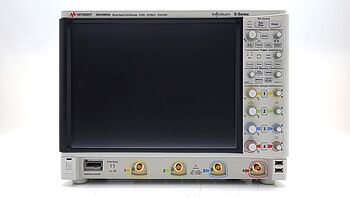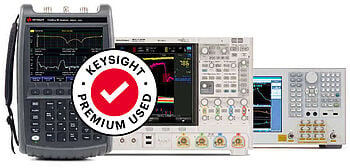- Introduction
- Understanding Fourier Transforms
- Mathematical Definition
- Discrete Fourier Transform (DFT)
- Fast Fourier Transform (FFT)
- Applications of Fourier Transforms
- Signal Processing
- Communications
- Electromagnetic Analysis
- Control Systems
- Fourier Transform Properties
- Comparison of Fourier Transform Variants
- Fourier Transforms in Testing Equipment
- Oscilloscopes
- Spectrum Analyzers
- Network Analyzers
- Limitations and Challenges of Fourier Transforms
- Conclusion
- Whenever You’re Ready, Here Are 5 Ways We Can Help You
Have you ever wondered how complex signals can be broken down into simpler components?
Fourier transforms provide a powerful mathematical tool to analyze and understand such signals by decomposing them into their constituent frequencies. Engineers and scientists use this transformation extensively in signal processing, telecommunications, and control systems.
Understanding Fourier Transforms
A Fourier transform converts a time-domain signal into its frequency-domain representation.
This transformation allows you to analyze the different frequency components present in the signal, which is particularly useful in fields like electrical engineering, signal processing, and communications.
| Key Takeaway |
|---|
| Fourier transforms allow engineers to analyze signals in the frequency domain, making it easier to identify noise, harmonics, and system performance issues. Whether in signal processing, communications, or RF testing, mastering Fourier analysis is essential for optimizing and troubleshooting electronic systems. |
Mathematical Definition
For a continuous-time function f(t), the Fourier transform F(ω) is defined as:
\(F(\omega) = \int \limits_{-∞}^∞ f(t) e ^{-i \omega t}dt\)
Here, ω represents the angular frequency in radians per second. The inverse Fourier transform reconstructs the original time-domain signal from its frequency-domain representation:
\(f(t) = {\frac{1}{2\pi}}\int \limits_{-∞}^∞ F(\omega) e ^{i \omega t}d\omega\)
Discrete Fourier Transform (DFT)
In practical applications, especially when dealing with digital data, you often work with discrete signals. The Discrete Fourier Transform (DFT) is used to analyze such signals. For a sequence of N samples x[n], the DFT X[k] is given by:
\(X (k) = \sum \limits_0^{N-1} x(n)e ^{-\frac{i2\pi kn}{N} }\)
The inverse DFT (IDFT) allows you to transform frequency-domain data back into the time domain:
\(x (n) = \frac{1}{N} \sum \limits_0^{N-1} X(k)e ^{\frac{i2\pi kn}{N} }\)
Fast Fourier Transform (FFT)
Computing the DFT directly requires a large number of calculations, making it computationally expensive. The Fast Fourier Transform (FFT) is an efficient algorithm that reduces computation time significantly. Instead of the O(N²) operations required for a direct DFT, FFT reduces it to O(N log N), making it feasible for real-time applications.
Applications of Fourier Transforms
Fourier transforms have broad applications across multiple fields, allowing engineers and scientists to analyze and manipulate signals efficiently.
Whether in electronics, telecommunications, medical imaging, or mechanical diagnostics, Fourier analysis plays a crucial role in extracting meaningful information from signals.
Signal Processing
In signal processing, Fourier transforms help analyze and filter signals in various applications, such as audio and speech recognition.
By transforming signals into the frequency domain, engineers can remove noise, enhance specific frequency components, and apply digital filters. Examples include:
- Audio compression: Formats like MP3 use Fourier-based transformations to remove inaudible frequencies and reduce file size.
- Noise reduction: Digital filters designed using Fourier analysis eliminate unwanted interference in communications and sensor data.
- Seismic data processing: Fourier transforms help geophysicists analyze earthquake signals and detect underground structures.
Communications
Modern communication systems rely on Fourier analysis for efficient signal transmission and reception. Fourier transforms play a key role in:
Modulation and demodulation: Techniques such as Amplitude Modulation (AM) and Frequency Modulation (FM) depend on frequency domain transformations.
Orthogonal Frequency Division Multiplexing (OFDM): Used in 4G, 5G, and Wi-Fi networks, OFDM employs FFT to split signals into multiple frequency sub-bands for more efficient data transmission.
Radar and sonar signal processing: Fourier transforms help analyze reflected signals to detect objects and measure distances.
Electromagnetic Analysis
Fourier transforms also play a crucial role in electromagnetic field analysis and antenna design. Engineers use Fourier-based techniques to:
- Analyze signal propagation: Understanding how signals propagate through different media is crucial for designing antennas and communication links.
- Simulate electromagnetic fields: Fourier analysis aids in solving Maxwell's equations for wave propagation in various environments.
- Filter interference in RF circuits: Frequency domain techniques help eliminate unwanted harmonics and noise in radio-frequency system
Control Systems
In control engineering, Fourier transforms are used to analyze system stability and design controllers. Applications include:
- Frequency response analysis: Engineers use Bode plots and Nyquist diagrams, derived from Fourier transforms, to assess system performance.
- PID controller tuning: Fourier techniques help optimize proportional-integral-derivative (PID) controllers for better stability and response.

Fourier Transform Properties
Fourier transforms have several important properties that simplify analysis and computation:
- Linearity: If f1(t) and f2(t) have Fourier transforms F1(ω) and F2(ω), then for any constants a and b:
- Fourier{a f1(t) + b f2(t)} = a F1(ω) + b F2(ω)
- Time Shifting: If f(t) has a Fourier transform F(ω), then shifting in time results in:
- Fourier{f(t – t0)} = e(-iωt0) F(ω)
- Frequency Shifting: Multiplying a function by a complex exponential shifts its frequency:
- Fourier{eiω0t f(t)} = F(ω – ω0)
- Convolution: The Fourier transform of a convolution of two signals equals the product of their individual Fourier transforms:
- Fourier{f1(t) * f2(t)} = F1(ω) F2(ω)
- Parseval’s Theorem: The total energy of a signal remains the same in both time and frequency domains:
- \(\int |f(t)|^2dt= \frac{1}{2\pi} \int |F(\omega|^2d\omega\)
- \(\int |f(t)|^2dt= \frac{1}{2\pi} \int |F(\omega|^2d\omega\)
Comparison of Fourier Transform Variants
The table below highlights the differences between common types of Fourier transforms:
Transform Type | Input Type | Output Type | Use Case |
Continuous Fourier Transform (CFT) | Continuous-time signal | Continuous frequency spectrum | Theoretical analysis of signals |
Discrete Fourier Transform (DFT) | Discrete-time signal | Discrete frequency spectrum | Digital signal processing |
Fast Fourier Transform (FFT) | Discrete-time signal | Discrete frequency spectrum | Efficient DFT computation |
Short-Time Fourier Transform (STFT) | Time-varying signal | Time-frequency representation | Speech processing and music analysis |
Fourier Transforms in Testing Equipment
Fourier transforms play a crucial role in modern electronic testing equipment by allowing engineers to analyze signals in both the time and frequency domains.
Many diagnostic tools rely on Fourier analysis to identify signal distortions, noise, harmonics, and other frequency-based characteristics that impact system performance.
Oscilloscopes
Many digital oscilloscopes include built-in Fast Fourier Transform (FFT) functions that allow users to switch between time-domain and frequency-domain views of a signal. This feature helps engineers:
- Identify harmonics and noise: Fourier analysis reveals unwanted frequency components that may be affecting circuit performance.
- Analyze transients and spikes: By observing signal behavior in the frequency domain, engineers can diagnose transient disturbances or oscillations.
- Test communication signals: In RF and wireless applications, FFT enables the verification of modulated signals and spectral occupancy.
Spectrum Analyzers
Spectrum analyzers specifically focus on displaying the power spectrum of a signal using Fourier transforms. Engineers use them to:
- Measure signal strength at different frequencies: This helps detect interference, harmonics, and spurious emissions in RF and microwave systems.
- Characterize modulated signals: In telecommunications, spectrum analyzers ensure proper modulation in AM, FM, and digital communication systems.
- Verify compliance with standards: Many industries set limits on spectral emissions, and Fourier-based analysis helps confirm adherence to regulatory guidelines.
Network Analyzers
Network analyzers use Fourier transforms to evaluate how electrical networks respond to different frequency components. These instruments are critical for:
- Measuring impedance and phase response: Engineers use them to test components such as filters, amplifiers, and antennas.
- Characterizing transmission and reflection coefficients: Fourier transforms help assess how signals propagate through different networks.
- Detecting frequency-dependent signal distortions: Fourier-based techniques assist in analyzing phase shifts and attenuation across different frequency bands.
By leveraging Fourier analysis in testing equipment, engineers can diagnose and optimize electrical and communication systems more effectively.
Whether troubleshooting RF circuits, ensuring signal integrity, or analyzing dynamic system responses, Fourier-based tools provide critical insights into signal behavior.
Limitations and Challenges of Fourier Transforms
While Fourier transforms are powerful tools, they have some practical limitations:
- Resolution trade-offs: The Fourier transform cannot provide precise time and frequency information simultaneously due to the uncertainty principle.
- Computational complexity: Despite FFT optimizations, analyzing large datasets or real-time signals can be resource-intensive.
- Windowing effects: In DFT and FFT, improper window selection can cause spectral leakage, leading to inaccurate frequency representation.
- Non-stationary signals: Fourier analysis assumes stationary signals, making it less effective for rapidly changing signals where alternatives like the Short-Time Fourier Transform (STFT) or wavelet transform may be better.
Understanding these challenges helps engineers choose the right signal analysis techniques for their applications.
Conclusion
Fourier transforms are essential for analyzing signals in both the time and frequency domains. They help engineers filter noise, identify frequency components, and optimize system performance.
Whether in signal processing, communications, medical imaging, or testing equipment, Fourier analysis provides critical insights for diagnosing and improving electronic systems.
For high-quality, reliable testing equipment, explore the Keysight Used Equipment Store. You’ll find premium used oscilloscopes, spectrum analyzers, function generators, and multimeters—all rigorously tested and calibrated to meet your needs. Visit Keysight today and equip your lab with the tools you can trust.

Whenever You’re Ready, Here Are 5 Ways We Can Help You
- Browse our Premium Used Oscilloscopes.
- Call tech support US: +1 800 829-4444
Press #, then 2. Hours: 7 am – 5 pm MT, Mon– Fri - Talk to our sales support team by clicking the icon (bottom right corner) on every offer page
- Create an account to get price alerts and access to exclusive waitlists.
- Talk to your account manager about your specific needs.
